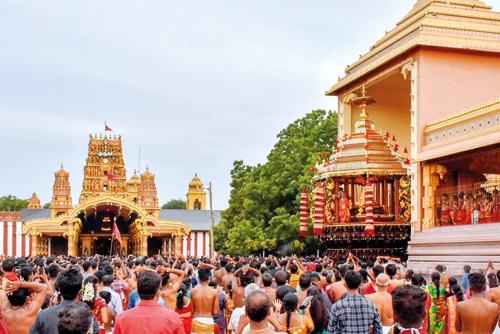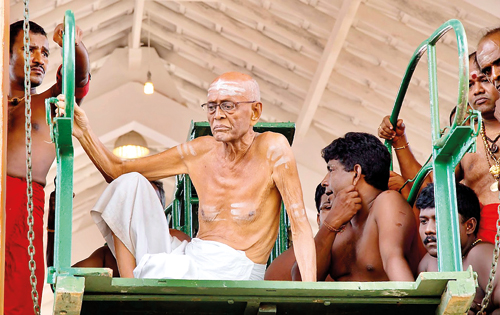Nallur temple: A powerful legacy to uphold

Throng of devotees at Nallur temple. Pic by Sivashanthan
The piercing sound of the nadaswaram filled the air. A soul-rending call, expressing the constant yearning of the human spirit, I would hear echoes of it in dark spaces in New York in the sound of the tenor saxophone. It was “ther” day at the Nallur Kandasamy temple and musicians came from all over Sri Lanka and India to compete with each other, one drummer more powerful than the next.
As the afternoon faded, Lord Skanda, dressed in green, would be taken back to his abode, dancing on the shoulders of his followers. These scenes from my childhood have always associated music and dance with the sacred and the divine.
Home for my brother and cousins in our early childhood was where my grandmother and great grandmother lived.
Every school holiday was spent with them in Nallur. For the privileged classes, Jaffna was a very matrilocal place, large dowried property staying with the daughter and wife. This gave women of the wealthy classes enormous power over their husbands, households and communities. While my grandfather, who was once GA Jaffna, a senator and High Commissioner in New Delhi, held court on the front verandah, all the business that mattered to people was being conducted on the side verandah where my great grandmother and grandmother sat. Who would marry whom? How much dowry would be paid? What were the latest land deals? How to resolve disputes in the community? How to preserve rituals, practices and also very important, temple management- what needs to be done on a daily basis? These were all within the purview of my great grandmother and after that my grandmother. The side verandah wielded enormous power and to us children, was the source of all authority.
The Nallur Kandasamy Kovil, situated down the road was one of the main preoccupations of the women in my family, especially my grandmother. My early childhood was overhearing conversation of how it had fallen into disrepair and the constant discussion on how to make it better.
My great grandmother and grandmother along with much of Nallur had set their eyes on Kumaradas Maapana Mudaliyar as the young man who would rescue the temple. Kumaradas, as he was fondly called, was the second son in line for the Nallur inheritance. Educated at Jaffna Central College and St. Peter’s College Colombo, he wanted to follow a career in medicine. But the scheming aunties of Nallur, among others, had his brother, the natural inheritor of custodianship, request Kumaradas to take charge. When his brother died in 1964, Kumaradas became the full custodian and guided the temple till he died on October 9, 2021.

Simplicity and authority: Kumaradas Maapana Mudaliyar. Pic by Visakan
Initially Kumaradas brought scientific precision and strategic planning into the running of the temple. Overnight, rituals, poojas and programmes began to run on time. Kumaradas was a perfectionist, focusing on the details, synchronizing the priests and musicians with symphonic precision and great devotion. Soon Nallur, the rest of Jaffna and Sri Lanka responded. The crowds became larger. By the 1980s it had become the premier temple of the Northern province.
As the crowds grew, Kumaradas began to make structural innovations. Entrances were added and enlarged and there were major changes to the architecture. The war created its own dilemmas. The long processions along the streets had to be curtailed so further structural changes were made to provide space and to protect the crowd. There was a grandiosity to the temple now – a friend called it the Vatican of the North.
Not everyone was happy with the changes but Kumaradas’s sense of magnificence and efficient running of the temple drew devotees and largesse from all over the world. Despite the war, faith in the temple did not diminish – perhaps there was need for security and certainty. Among the worshippers were members of the security forces who saw the link between Lord Skanda and Lord Kataragama.
One of the most important people in this transformation of the temple was Sugirtha Namasivayam, Kumaradas’s wife. One of the most beautiful and talented young women of her generation, she helped Kumaradas in designing the apparel and aesthetics of temple festivals and there was great admiration for her innovative designs. Priests they trained went to other temples throughout Sri Lanka and India.
The Nallur temple was Kumaradas’s passion throughout his life. Even in his nineties and till a few days before he died, he would be there, bare-chested, in a pure white “verti” and shawl, seated on the floor leaning on a pillar. A man of great asceticism and discipline, his radical simplicity inspired awe in all of us. Thanks to him our childhood was full of spectacle, drama and beauty. Worship was never boring. His reign will always be known as the “glory days” of the Nallur Temple.
Recent articles in the papers hint that certain groups and associations are trying to make Nallur a place of exclusivity. These are very disturbing to read. There is an alternative history of the Nallur temple that must also be placed on record – an egalitarian tradition that must be rekindled.
I was in fifth grade at the United Nations International School in New York as my father had accepted a post at the United Nations. We were studying world religions and a young Australian teacher was teaching us Hinduism. “Hinduism is known for its caste system. That is what makes it different to all other religions,” she said going on to graphically describe the caste system. This was my first encounter with the arrogant gaze of the colonizer. I challenged her, burst out crying and told her she was telling lies. I was so rowdy that I was sent to the Principal’s office. They sent for my father to come and take me home.
In the forty minute ride to the suburbs my father shocked me by admitting that such a thing exists. Suddenly the inequality that you felt at a subconscious level just below the skin began to make sense. My father said that his generation, inspired by the Indian nationalist movement, was determined to fight against this shameful history.
He told me how my grand uncle S. Somasunderam, a disciple of Gandhi, along with Kumaradas’s father were determined to join other progressive groups in Jaffna and walk with the Dalits into Nallur Kandasamy Kovil. Of course nothing could be done without my great grandmother’s permission. They were all very worried but endorsing the move, she sang a famous song where Lord Shiva moves the statue in front of him so that a Dalit can see him unhindered from the outskirts of the temple. The temple doors were flung open in 1956. Selvy Tiruchandran in her recent book on caste confirms that Nallur was one of the first temples that opened its doors to all worshippers.
Kumaradas understood this tradition of equality. He kept the practice that men should be bare chested inside the temple. A sign of respect, it was also to remove markers of caste and class so that everyone would be equal before God. The arichinai (puja) still costs Rs 1/– the same amount as at the time he became custodian. He was determined that everyone should be able to make an offering and even the poorest should have access. From 1956 members of all classes and castes have carried the deity unlike in many other temples. During the war the temple also opened its doors to the internally displaced and tried to be involved in serving the community.
Even before Kumaradas’s time, in the 1870s, the Trustees and priests had come under attack from Arumugha Nawalar who some felt was trying to impose a newly invented version of Hinduism on the people of Jaffna, imitating many of the practices of the missionaries without the humanism. Navalar wanted the “vel” or spear removed as an object of worship in the temple because it did not fit into his textual “agamic” traditions. The management refused, saying the “vel” is what the people of Jaffna have always worshipped.
Temples are sustained by their faith – they reflect the values of the community of worshippers. Kumaradas’s son Shayan is now the full custodian of the temple. He is a talented young architect and his wife a devoted professional. Together they are well placed to face the challenges of the 21st century. We know they will set aside exclusivity and draw on the progressive traditions of their ancestors that seem to suggest that this temple is for the people.
Searching for an ideal partner? Find your soul mate on Hitad.lk, Sri Lanka's favourite marriage proposals page. With Hitad.lk matrimonial advertisements you have access to thousands of ads from potential suitors who are looking for someone just like you.


